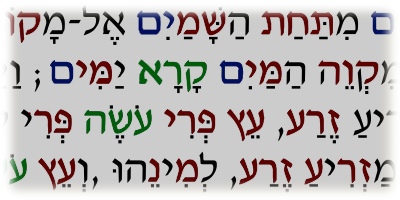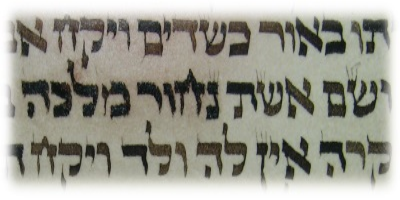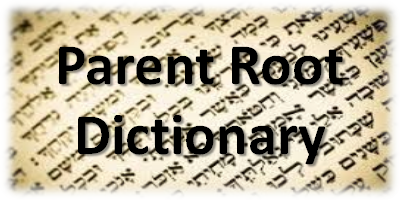Hebrew Nouns
The most common noun form is the use of the two-letter or three-letter root. The parent root אב (AB, Strong's #1) is a noun and means "father." The child root אור (A.W.R), can be a verb meaning to "enlighten" (Strong's #215), but is also used as a noun meaning "light" (Strong's #216). The adopted root פתח (P.T.Hh), can be a verb meaning to "open" (Strong's #6605) but is also used as a noun meaning a "door," or opening (Strong's #6607).
Noun Derivatives
Additional nouns are formed out of the root by adding specific letters in specific places within the root. The noun derivative מפתח (maph'tach), meaning a key, is formed by adding the letter מ (m) to the front of the root פתח (P.T.Hh). The most common noun derivatives are formed by placing a מ (m) or ת (t) in front of the root or by placing a י (i) or ו (o or u) inside the root.
Feminine Derivatives
In Hebrew all nouns are either masculine or feminine. In most cases a feminine noun is formed by adding ה (ah), ת (et) or ית (iyt) to the end of a noun.
Plural Nouns
Masculine nouns are made plural by adding the suffix ים (iym) and Feminine nouns are made by adding the suffix ות (ot). In some cases, masculine words, usually very ancient words, will use the ות (ot) suffix. For example, the Hebrew words אב (av - father) and אור (or - light) are masculine words but are written as אבות (avot) and אורות ('orot) in the plural.
Grammatical Tools
Hebrew uses nouns for other functions within the sentence. They can be used as adjectives, adverbs, prepositions, conjunctions, etc. The noun עקב (eqev) is a noun meaning the "heel" of the foot, but it can also be used as a particle and is translated as "because," in the sense of "what has been said" is on the "heel" of what is "about to be said."
Hebrew Verbs
Because the Hebrew language is an action oriented language rather than descriptive, it is prolific with verbs. When a Hebrew verb is conjugated in a sentence it identifies person, number, gender, tense, mood and voice. Understanding these different aspects of a verb, while not essential for proper Biblical interpretation, it is very helpful when learning how to translate the Hebrew text.
Person
Each verb identifies the subject of the verb as first (I), second (you) or third (he/she) person.
Number
Each verb also indicates the subject of the verb as singular or plural (we, you or they).
Gender
Each verb also indicates the subject of the verb as masculine or feminine.
Tense
There are four tenses in Hebrew verbs, perfect, imperfect, participle and imperative. In the English language the verb tenses are related to time; past, present and future, while the Hebrew verbs are all related to action. The perfect tense is a completed action and in most cases is related to the English past tense (he cut). The imperfect tense is an incomplete action and is closely related to the English present and future tenses (he cuts or he will cut).
When a Hebrew verb is prefixed with the letter vav it means "and," but it also reverses the tense of the verb. For example, the verb אמר (amar) means "he said," and is in the perfect tense, but when it is written as ואמר (v'amar) it means "and he will say."
Voice
Each verb also includes voice of which there are three; active, passive or reflexive. The active voice identifies the action of the verb as coming from the subject (he cut). The passive voice does not identify the origin of action placed on the subject of the verb (he was cut). The reflexive voice places the action of the verb onto the subject (he cut himself).
Mood
Each verb also includes mood of which there are three; simple, intensive or causative. The simple mood is simple action of the verb (he cut). The intensive mood implies force or emphasis on the verb (he slashed or hacked). The causative mood expresses causation to the verb (he caused a cut).
The voice and mood of a verb are identified by seven different names as shown in the table below.
| Form | Mood | Voice | Example |
|---|---|---|---|
| Paal (Qal) | Simple | Active | He cut |
| Niphal | Simple | Passive | He was cut |
| Piel | Intensive | Active | He slashed |
| Pual | Intensive | Passive | He was slashed |
| Hiphil | Causative | Active | He made cut |
| Hophal | Causative | Passive | He was made cut |
| Hitpael | Intensive | Reflexive | He slashed himself |
Here are a few examples of the conjugated verb אבד (ABD), meaning "to perish."
| Verse | Exodus 10:7 | |
| Hebrew | אָבְדָה | |
| Transliteration | av'dah | |
| Person | 3rd | |
| Number | Singular | |
| Gender | Feminine | |
| Tense | Perfect | |
| Voice | Simple | |
| Mood | Active | |
| Translation | she perished |
| Verse | Leviticus 23:30 | |
| Hebrew | וְהַאֲבַדְתִּי | |
| Transliteration | v'ha'vad'tiy | |
| Person | 1st | |
| Number | Singular | |
| Gender | Common | |
| Tense | Perfect | |
| Voice | Causative | |
| Mood | Active | |
| Translation | and he I will cause to perish (I will destroy) |
| Verse | Numbers 16:33 | |
| Hebrew | וַיֹּאבְדוּ | |
| Transliteration | vai'yov'du | |
| Person | 3rd | |
| Number | Plural | |
| Gender | Masculine | |
| Tense | Imperfect | |
| Voice | Simple | |
| Mood | Active | |
| Translation | and they perished |
| Verse | Numbers 33:52 | |
| Hebrew | וְאִבַּדְתֶּם | |
| Transliteration | v'iy'bad'tem | |
| Person | 2nd | |
| Number | Plural | |
| Gender | Masculine | |
| Tense | Perfect | |
| Voice | Intensive | |
| Mood | Active | |
| Translation | and you will utterly destroy |
Like what you’re discovering? Continue the journey from Bible reader to translator.
|






